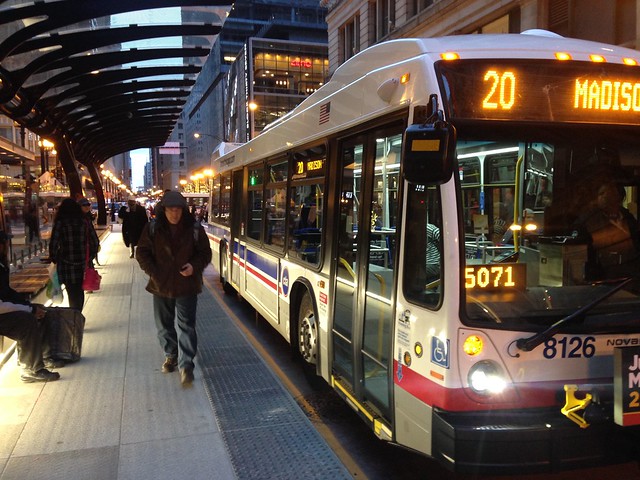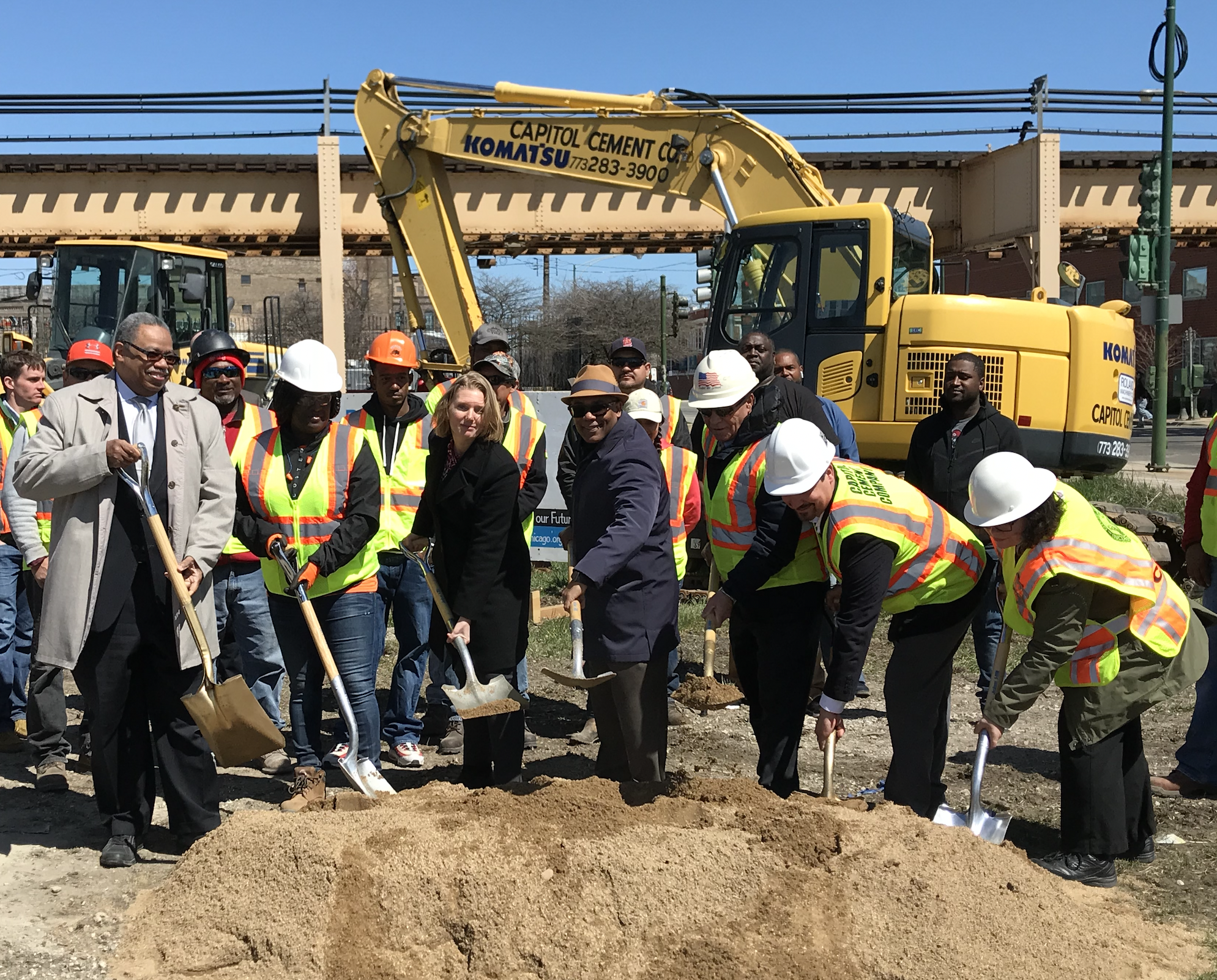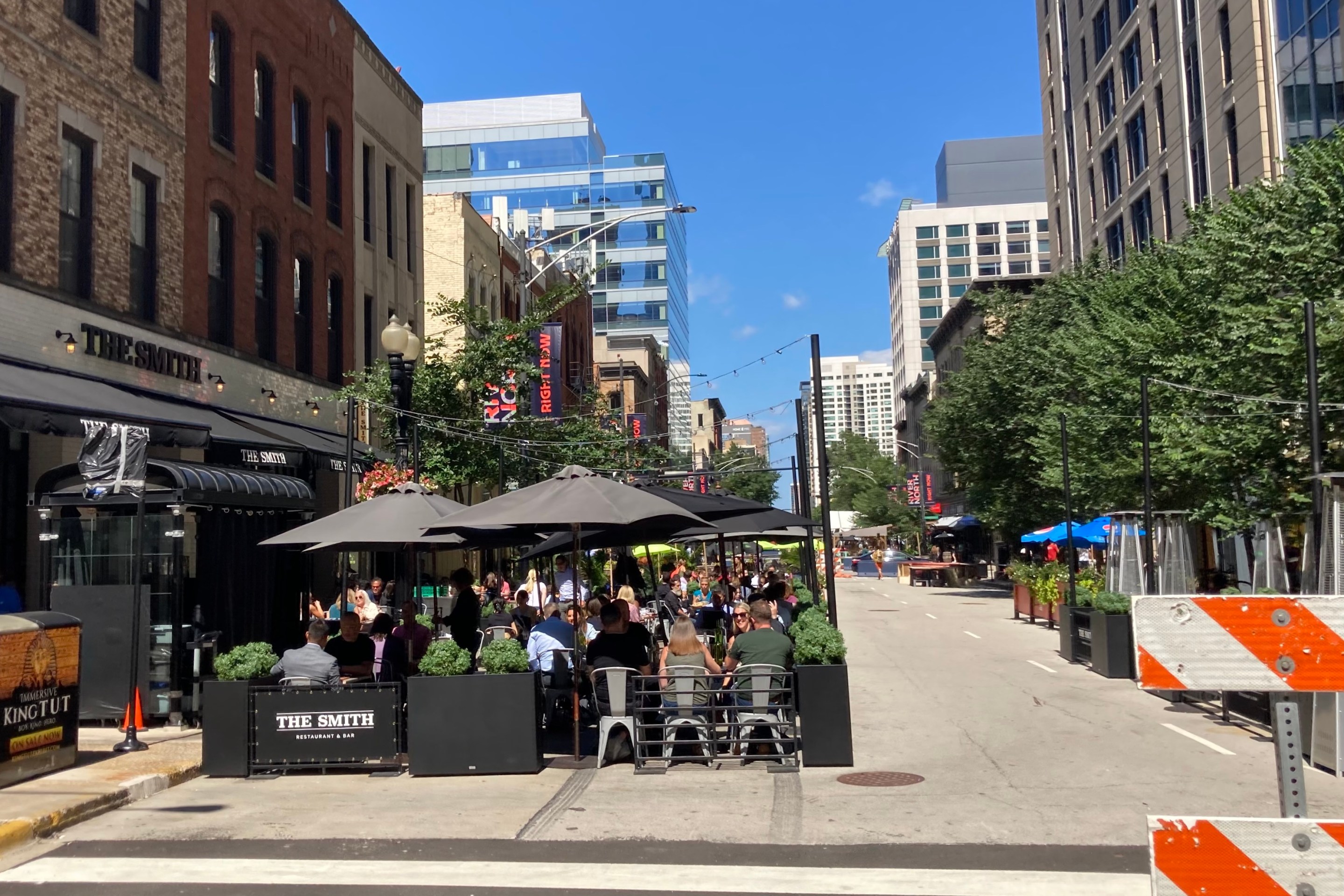Why Are Loop Link Buses Moving So Slow, and Will They Get Faster?
11:53 AM CST on December 23, 2015
Since Chicago's Loop Link bus rapid transit corridor launched last Sunday, there's been little or no improvement in bus travel times along the route. It turns out that a big part of the problem is that the CTA currently requires bus operators to drive at walking speed while passing by the long, raised station platforms. Hopefully, as operators and CTA customers get used to the new infrastructure, bus speeds will get much faster.
The city of Chicago certainly deserves kudos for launching Loop Link, a bold reconfiguration of street space to prioritize transit, walking, and biking. In fact, the redesign of Washington Street as part of the system was nominated for the Streetsblog network’s “Streetsie” award as one of the nation’s best urban street transformations of 2015.
However, for Chicagoans to feel that repurposing several mixed-traffic lanes was worth it, and for there to be any chance of moving forward with the city’s Ashland BRT proposal, it’s crucial for Loop Link to provide significant benefits in terms of faster, more reliable bus service. The city has said the goal of the project is to double downtown bus speeds from their previous molasses-like pace of 3 mph during rush hours.
Obviously, any brand-new transportation system is likely to have a few bugs, and there was bound to be a learning curve while all road users get comfortable with the new layout. When I test-rode the system on Sunday, I noticed that the buses weren’t moving much faster than before, even when the red bus-only lanes were free of other vehicles, and they were especially slow when pulling up to the platforms. I chalked that up to the operators being especially cautious while learning to navigate the route.
But when I rode the #20 Madison bus downtown from the West Side on Tuesday afternoon, I overheard several commuters, who seemed like daily riders, complaining about Loop Link. “These platforms make the trip take a lot longer,” said one lady. “Whoever brainstormed this doesn’t have all their faculties intact,” replied her companion. They strategized about different bus lines they could take to avoid the BRT corridor.
As we entered the Loop, predictably, there were issues with a few motorists driving in the red lane, and others stopping in it to drop off and pick up passengers. At one point, the bus got stuck behind a long line of cars crossing the bus lane to make a right turn onto Clark Street. At no time did our driver leave the lane to pass stopped vehicles, including other buses as the platforms. This meant we always waited until all the buses in front of us were finished dropping off and picking up passengers before proceeding.
It took a full 16 minutes to travel the 0.8 miles between Canal Street and Michigan Avenue. That’s 3 mph, the same speed as before Loop Link was established, when buses were stuck in car-generated traffic jams. Since the buses often seemed to be moving sluggishly for no good reason, it seemed even slower.
When I asked the bus driver how she felt Loop Link is working out, she complained that the new system is “causing congestion” for the buses. She said operators were told to drive only 1 mph in the lanes, and there are no plans to raise the speed limit.
That sounded far-fetched, so after I returned to the platform at Washington and State, I spoke with a CTA supervisor who was serving as an air traffic controller for buses, waving the drivers in towards the platform. He told me that the drivers are, in fact, instructed to drive 1 mph alongside the stations, because the raised platform means that people who stand in the dark gray, textured area near the platform edge are in danger of being struck in the head by the buses' rearview mirrors. He added that the speed limit will be raised once customers get used to standing away out of the way of the mirrors.
CTA spokeswoman Tammy Chase told me it’s true the drivers currently have a speed restriction near the platforms due to the mirror issue, but it’s actually 3 mph, and they can go the normal 30 mph speed limit on other parts of the route. She noted that it was rainy on Monday, which also caused bus operators to drive more cautiously.
Chase said the mirror issue was “very much anticipated” and didn’t indicate that the agency has any plans to change the height of the mirrors. “That’s why the supervisors are there, to help the operators safely reach the platforms while they get used to the system,” she said.

As a further precaution, drivers are instructed to maintain a few inches from the platform, rather than pull up flush with it. However, as you can see in the above video, when buses are too far away, this negates some of the convenience of "near-level" boarding by forcing riders to hop from the platform to the bus as if they were crossing a river on stepping stones. It's also a potential safety hazard.
The CTA is considering adding signs warning customers to stay out of the dark gray zone while waiting, Chase said. She compared the situation to that on ‘L’ platforms, where riders are advised to stay behind the blue tactile plates by the edge. Of course, if you do stand near the edge of the tracks, there’s no danger that you will be injured by an object hanging off the train.
Chase implied that as operators and customers get used to the system, the speed restriction by the platforms will be raised. She also told me that bus drivers are allowed to exit the red lanes in order to pass stopped vehicles, and they don’t have to wait for the buses in front of them to leave the platform first.
“We're closely monitoring performance, and will continue to look for ways to make small adjustments to maximize performance,” Chase said. “We definitely expect overall performance to become even more smooth as motorists and pedestrians become familiar with the corridor.”
I’m optimistic that, as operators become more confident and begin driving less gingerly, and more car drivers learn to stay out of the lanes, Loop Link bus speeds will improve significantly. In addition, the CTA plans to pilot off-board fare collection at the station at Madison and Dearborn next year, and if it’s eventually implemented at all the stations, it will be a big timesaver. In the video above, you can see that it took almost 30 seconds for all the passengers to board and swipe their Ventra cards or pay with cash -- a significant time-suck.
In the meantime, the CTA needs to do better job of getting the word out about why the buses are currently moving so slowly by the platforms, and encouraging operators to drive faster in other parts of the corridor. The agency also needs to explain that Loop Link will eventually make bus travel much faster than it was before the street redesign.
Update 12/23/15, 3:40 p.m.: Read how Cleveland's HealthLine BRT system prevents customers from being struck by bus mirrors.
![]()
Did you appreciate this post? Streetsblog Chicago is currently funded until April 2016. Consider making a tax-deductible donation through our PublicGood site to help ensure we can continue to publish next year.
In addition to editing Streetsblog Chicago, John writes about transportation and other topics for additional local publications. A Chicagoan since 1989, he enjoys exploring the city on foot, bike, bus, and 'L' train.
Read More:
Stay in touch
Sign up for our free newsletter
More from Streetsblog Chicago
Pressure is mounting to replace embattled CTA President Dorval Carter
Here's a look at what elected officials and other media outlets have said about the issue recently.
Service boost means BNSF Line will get Metra’s first-ever across-the-board weekend schedule, starting April 29
In addition, Halsted Street station will get weekend service, and Downers Grove's Fairview stop will become an off-peak stop.
Tasty news: Friedman Properties is trying to break the Clark outdoor dining stalemate by applying for street closure permits
Mayor Johnson's administration and Ald. Reilly haven't yet found common ground on bringing back the popular car-free zone. Will this make the difference?




